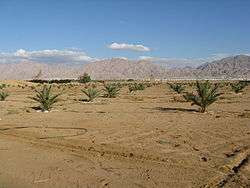Arabah

The Arabah (Hebrew: הָעֲרָבָה, HaAravah, lit. "desolate and dry area";[1] Arabic: وادي عربة, Wādī ʻAraba), known in Hebrew as Arava or Aravah, is a geographic name for the area south of the Dead Sea basin which forms part of the border between Israel to the west and Jordan to the east.
The old meaning, which was in use up to the early 20th century, covered almost the entire length of what is today called the Jordan Rift Valley, running in a north-south orientation between the southern end of the Sea of Galilee and the northern tip of the Gulf of Aqaba at Aqaba/Eilat. This included the Jordan River Valley between Sea of Galilee and Dead Sea, the Dead Sea itself, and what is commonly called today the Arava Valley. The modern use of the term is restricted to this southern section alone.
Geography
The southern stretch of the Arabah is 166 km (103 mi) in length from the Gulf of Aqaba to the southern shore of the Dead Sea. Topographically, the region is divided into three sections. From the Gulf of Aqaba northward, the land gradually rises over a distance of 77 km (48 mi), and reaches a height of 230 m (750 ft) above sea level, which represents the watershed divide between the Dead Sea and the Red Sea. From this crest, the land slopes gently northward over the next 74 km (46 mi) to a point 15 km (9.3 mi) south of the Dead Sea. In the last section, the Arabah drops steeply to the Dead Sea, which is 417 m (1,368 ft) below sea level. The Arabah is scenic with colorful cliffs and sharp-topped mountains. The southern Arabah is hot and dry and virtually without rain.
There are numerous species of flora and fauna in the Aravah Valley.[2] Notably the Caracal, Caracal caracal, is found on savannas of the valley.[3]
History

In Biblical times, the Arava was a center of copper production; King Solomon is believed to have had mines here based on copper mines dating to his reign. The Arabah was home to the Edomites (Edom was called "Idumea" in Roman times). East of the Arabah was the domain of the Nabateans, the builders of the city of Petra.
Kibbutz Yotvata founded in 1957, was named for an ancient town in the area mentioned in the Bible. Kibbutz Lotan has a bird-watching center. The oldest moshav in the central Arava area is Ein Yahav.
The Israel–Jordan Peace Treaty was signed in the Arava on October 26, 1994. The governments of Jordan and Israel are promoting development of the region. There is a plan to bring sea water from the Red Sea to the Dead Sea through a canal (Red–Dead Seas Canal), which follows along the Arabah. This (long envisioned) project was once an issue of dispute between Jordan and Israel, but it was recently agreed that the project shall be constructed on and by the Jordanian side.
Demography
In 2004, the Jordanian administrative district of Wadi Araba had a population of 6,775.[4] Five major tribes comprise eight settlements on the Jordanian side: Al-S'eediyeen (السعيديين), Al-Ihewat (الإحيوات), Al-Ammareen (العمارين), Al-Rashaideh (الرشايدة), and Al-Azazmeh (العزازمة), as well as smaller tribes of the Al-Oseifat (العصيفات), Al-Rawajfeh (الرواجفة), Al-Manaja'h (المناجعة), and Al-Marzaqa (المرزقة), among others. The main economic activities for these Arabah residents revolve around herding sheep, agriculture, handicrafts, and the Jordanian Army.
Landmarks
Timna Valley Park is notable for its prehistoric rock carvings, some of the oldest copper mines in the world, and a convoluted cliff called King Solomon's pillars. On the Jordanian side is the famous Wadi Rum, which is famous among rock climbers, hikers, campers, and lovers of the outdoors.
Wadi Feynan Eco-Lodge, opened in Feynan, Jordan in 2005 by the Royal Society for the Conservation of Nature, is a candle-lit eco-lodge situated deep in the Arabah's remote landscape.
Jordanian localities
Below is a list of Jordanian population clusters in Wadi Araba:
|
The total population of the Jordanian portion of the region is 103,000, of which 96,000 live in Aqaba.
Israeli localities
Below is a list of Israeli localities in the Arava, from north to south (excluding Eilat which is actually the southmost).
The population of the Israeli portion is 52,000, of which 47,500 live in Eilat, and just over 5,000 live in 20 small towns north of Eilat, the largest of which is Yotvata, with a population of 610. The Israeli residents of the region are almost entirely Jews.
See also
- Arava Institute for Environmental Studies, academic program in Israel
- Nahal HaArava, a wadi in the northern part of the Arava
- Sands of Samar, an expanse of sand dunes in the southern Arava
- Southern District (Israel)
- Wadi Araba Crossing, southernmost border crossing between Jordan and Israel
References
- ↑ "עֲרָבָה" [Arava]. אנציקלופדיה מפה (in Hebrew). 6. Tel Aviv: Mapa. 2000. pp. 107–110.
השם קדום (דברים א 1 ועוד) ומשמעו אזור שומם ויבש
- ↑ Henry Chichester Hart. 1891, Some account of the fauna and flora of Sinai, Petra, and Wâdy Arabah, 255 pages
- ↑ C. Michael Hogan. 2009. Caracal: Caracal caracal, GlobalTwitcher.com, ed. N. Stromberg
- ↑ Jordan Department of Statistics. 2004
External links
| Wikimedia Commons has media related to Arabah. |
- WadiFeynan Eco-Lodge
- The Arava Institute for Environmental Studies
- Royal Society for the Conservation of Nature
- Wadi Araba Archaeological Research Project: Integrating Investigations of the Cultural Landscape of Wadi Araba since 1996. For Publications, see http://wadiaraba.tripod.com/waarpubs.htm
- Wadi Arabah Project: Crossing the Rift
- French Institute of Oriental Archaeology
Coordinates: 30°25′01″N 35°09′05″E / 30.41694°N 35.15139°E